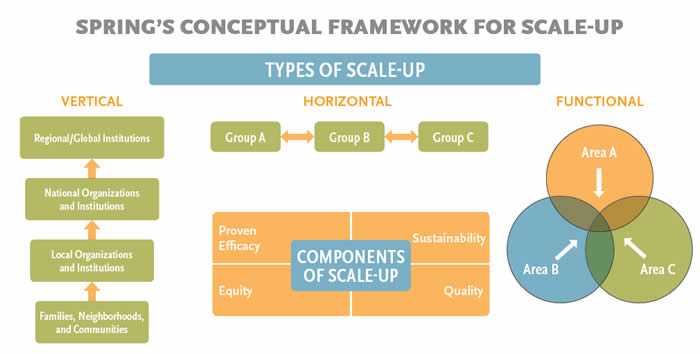Authors: Alexis D’Agostino, Meghan Anson, Anu Narayan, Tim Williams
Background: While many groups have attempted to define “scale-up,” little research has been done to determine how these definitions affect, or don’t, implementation. Nutrition is a special case for scale-up work since it is not encompassed by any one sector, but requires an interconnection between the health and food systems. Additionally, effective scale-up of nutrition requires an in-depth of understanding of how these systems work together to affect nutrition. SPRING conducted research to understand how implementers understand scale-up and how that understanding may be shaping the way nutrition work is being carried out.

Methods: SPRING conducted interviews with USAID nutrition project staff based in home and country offices. Data from these interviews were analyzed, using SPRING’s conceptual framework of nutrition scale-up, to determine how understanding of “scale-up” affects the development and implementation of nutrition programming, especially when scale-up is an explicitly named objective. Many thanks to the projects that participated in the exercise: ACCESO, Community Connector, FANTA III, LIFT II, MCHIP, Mwanzo Bora, SHIKHA, SPRING, Suaahara, TOPS, Yaajeende.

Results: While horizontal scale-up was the most commonly mentioned, most projects reported implementing multiple types of scale-up in their nutrition programming, as well as addressing multiple components of scale-up. Lacking an official definition, most nutrition projects rely on unofficial or personal understandings of scale-up. Unclear descriptions of scale-up lead to non-uniform methods for tracking and monitoring scale-up work, that may only illustrate limited aspects of scale-up, such as coverage. In addition, this lack of a definition doesn’t allow projects to effectively incorporate the systems thinking necessary to identify forces that will act as barriers or influencers to scale-up interventions.
| Challenges that Projects Identify in Effectively Scaling Up Nutrition |
|---|
| 1) Inputs Capacity: "Changing behaviors at scale takes a skillset." Funding: "We could do everything at scale if we had the money." Timing: "Doing sustainable work…requires a structure that takes time to develop." |
| 2) Implementation Integration: "Integration is everything when it comes to moving the bar on nutrition," versus "programming works even when there isn't full integration." Partnership: "Nobody can get credit for working together." |
| 3) Institutions Government: "Implementing …at district and village level, it's a different game." Donors: "Develop new ways of examining success...talk less about more and more about better." |
| 4) Environment Reach/Targets: "If you are only focused on rapid scale-up… [you are] going to miss something." Knowledge/Learning: "It feels like you're recreating the wheel every time." Theory: "Scale-up is not the end—scaling-up is the means." |
| How Projects Talk about Scale-Up |
|---|
| Many have a general understanding… "Scaling -up is identifying what works and making sure that as many people as possible have access to those tools, technologies or approaches." |
| …But it is not shared by all… "Scale-up is one of those terms that people maybe throw around a little too lightly…Something we all claim we understand…without stopping to define." |
| …And it depends on the project's mandate… "We can only take [scale-up] so far because it is based on whatever our contracts have asked us to do." |
| …Which might not stay constant over the life of the project. "As a program matures you learn more about scale…it's not just scaling- up technical interventions but you also need to think about delivery systems." |
Conclusions: Scholars generally agree that scale-up encompasses more than just coverage, but also issues of equity, quality, and sustainability.* All of these issues depend heavily on the interactions projects have with the systems within which they are operating. However, without a common understanding of the term that includes this broader view of scale-up, nutrition projects are stymied in their ability to develop programs that appropriately incorporate scale, monitor those programs, or achieve the scale-up they aim for. Effective systems-thinking can help projects address some of these challenges. Overall, projects reported that there is a lack of evidence on how best to reach scale in nutrition and the approaches and types of scale-up processes that are best for nutrition work. On a related note, projects do not agree on what integration does (or should) look like as an effort to support program scale-up. This is not surprising considering that integration for a nutrition project requires interactions with multiple systems, including health, agriculture, etc. Projects do agree, however, that current M&E processes and metrics are insufficient for measuring scale-up. With its role in defining mandates as well as reporting processes, USAID has the influence to affect how projects understand, approach, prioritize, and implement programs to reach scale.
* For more reading on this topic, see SPRING’s working paper, Defining Scale-Up of Nutrition Projects